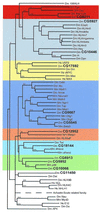A genomewide survey of basic helix-loop-helix factors in Drosophila
- PMID: 10973473
- PMCID: PMC27042
- DOI: 10.1073/pnas.170301897
A genomewide survey of basic helix-loop-helix factors in Drosophila
Abstract
The basic helix-loop-helix (bHLH) transcription factors play important roles in the specification of tissue type during the development of animals. We have used the information contained in the recently published genomic sequence of Drosophila melanogaster to identify 12 additional bHLH proteins. By sequence analysis we have assigned these proteins to families defined by Atonal, Hairy-Enhancer of Split, Hand, p48, Mesp, MYC/USF, and the bHLH-Per, Arnt, Sim (PAS) domain. In addition, one single protein represents a unique family of bHLH proteins. mRNA in situ analysis demonstrates that the genes encoding these proteins are expressed in several tissue types but are particularly concentrated in the developing nervous system and mesoderm.
Figures



References
-
- Murre C, McCaw P S, Baltimore D. Cell. 1989;56:777–783. - PubMed
-
- Blackwell T K, Weintraub H. Science. 1990;250:1104–1110. - PubMed
-
- Blackwell T K, Kretzner L, Blackwood E M, Eisenman R N, Weintraub H. Science. 1990;250:1149–1151. - PubMed
-
- Ma P C, Rould M A, Weintraub H, Pabo C O. Cell. 1994;77:451–459. - PubMed
-
- Ellenberger T, Fass D, Arnaud M, Harrison S C. Genes Dev. 1994;8:970–980. - PubMed
Publication types
MeSH terms
Grants and funding
LinkOut - more resources
Full Text Sources
Other Literature Sources
Molecular Biology Databases

